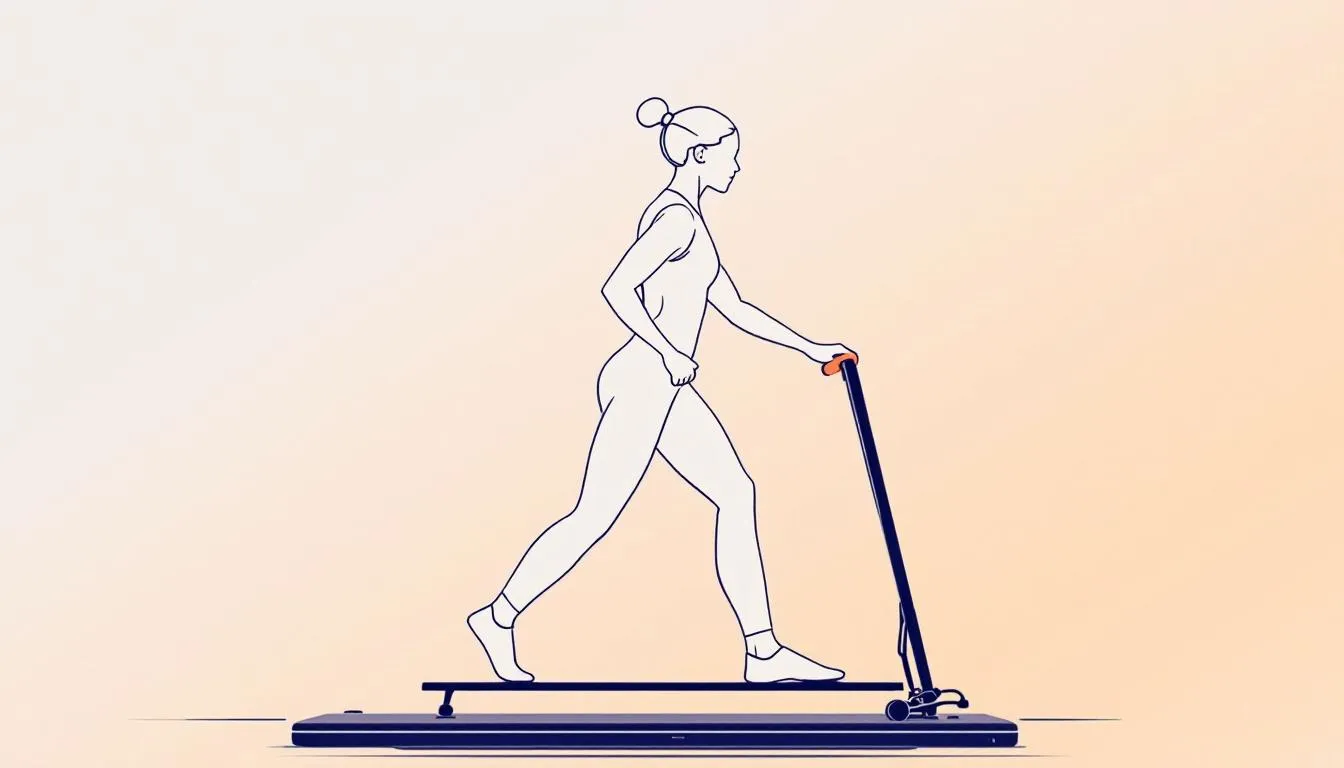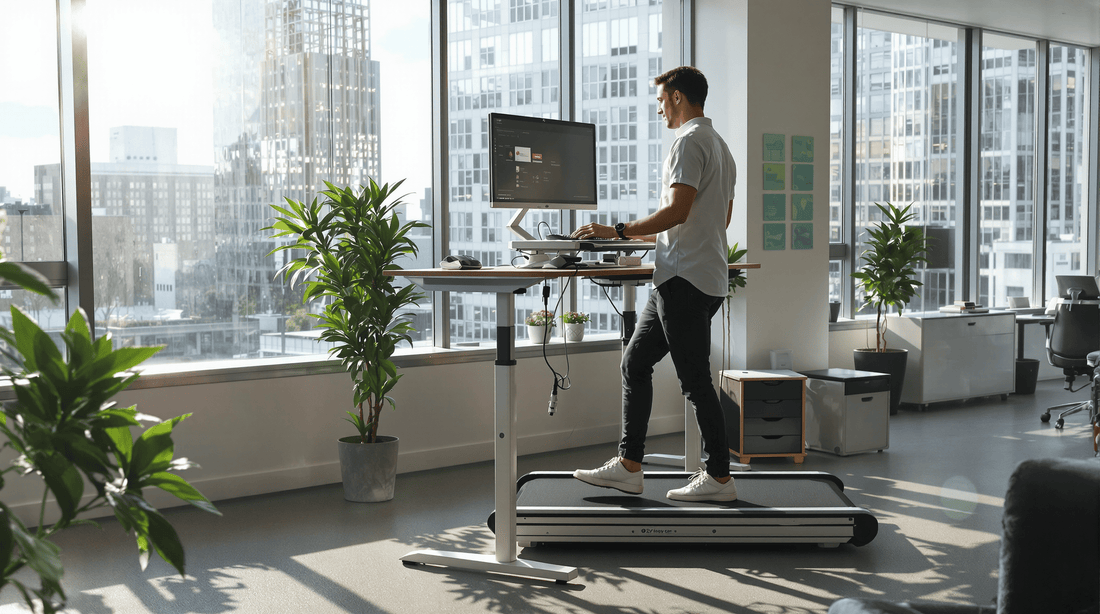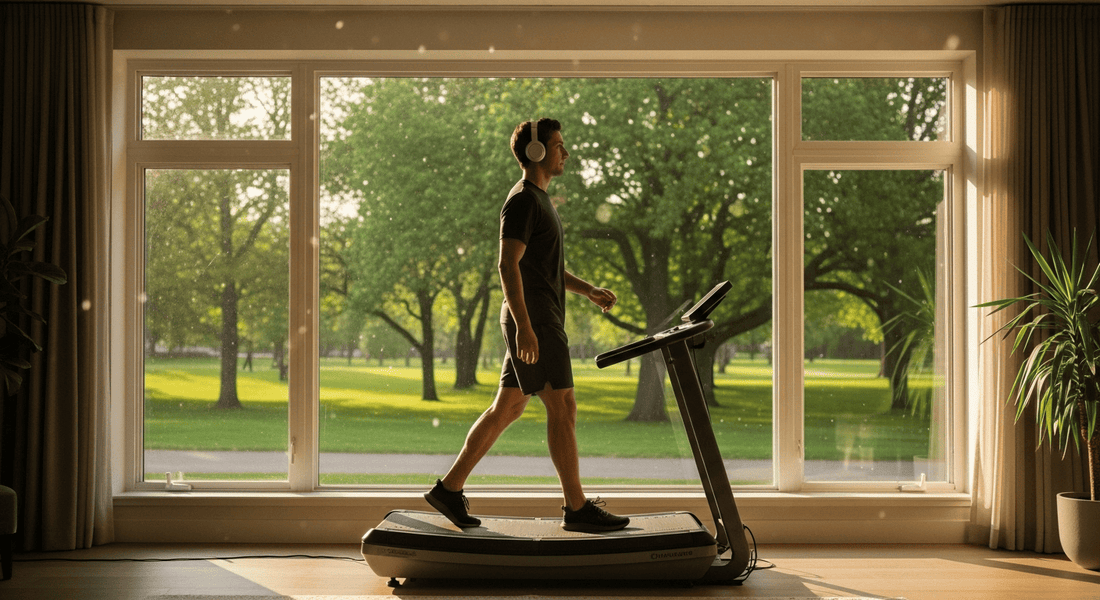The beauty of a walking pad—also called an under‑desk treadmill—is its versatility. Yes, steady walking is great for daily steps, but you can unlock far more fitness benefits by mixing in creative exercises that challenge different muscle groups and energy systems.
To get started, begin with short, manageable sessions to safely ease into creative walking pad workouts.
Below are five research‑backed, low‑impact walking‑pad workouts you can safely add to your routine—ideal for apartment dwellers, busy professionals, or anyone looking to fight workout boredom.
Quick Safety Notes
-
Start Slow: Try each move at 0.5–1 km/h first.
-
Use Stable Support: Keep desk rails or safety handles within reach.
-
Footwear Matters: Cushioned sneakers reduce joint impact.
-
Warm‑Up & Cool‑Down: 3–5 minutes of gentle walking before and after each session.
Why Use a Walking Pad? Key Benefits for Your Body and Mind
A walking pad isn’t just a convenient piece of fitness equipment—it’s a game-changer for your overall health and well-being. By adding a walking pad to your daily routine, you can experience a significant impact on both your body and mind. Regular use helps improve cardiovascular health, supports weight management, and increases calorie burn, all while fitting seamlessly into your lifestyle. Whether you prefer a brisk walk or a light jog, walking pads make it easy to stay active throughout the day, even when you’re answering emails or attending virtual meetings.
Unlike traditional gym sessions or outdoor runs, a walking pad allows you to exercise in the comfort of your home or office, making it an effective option for busy schedules. You can squeeze in a quick walk or jog during work breaks, helping you maintain a consistent routine and support your long-term health goals. With every step, you’re not just moving your body—you’re boosting your mood, sharpening your focus, and investing in your overall health.
1. Calf‑Raise Intervals
Targets: Gastrocnemius & soleus (calf muscles), Achilles flexibility
|
Setting |
Speed |
Sets × Reps |
|
Flat belt |
0.8 km/h |
3 × 20 raises |
-
Walk normally for 60 seconds. -
Grip the desk lightly, rise onto tiptoes, hold 2 seconds, lower slowly.
-
Repeat 20 reps, then resume normal walking for 60 seconds.
-
Complete 3 rounds.
Why it works: Calf raises boost ankle stability and improve stride efficiency—perfect for runners and high‑heel wearers alike.
2. Backward Walking Drills
Targets: Quadriceps, glutes, knee stabilisers; enhances proprioception
|
Setting |
Speed |
Duration |
|
Flat belt |
0.5–0.8 km/h |
5 minutes total |
-
Switch the belt on at a very low speed. -
Stand facing the console, then carefully turn 180°.
-
Keep a soft bend in your knees and land on the balls of your feet.
-
Swing arms gently for balance; focus on upright posture. Maintaining good posture during backward walking drills is important to prevent strain and support proper body alignment.
Progression Tip: Gradually lengthen backward‑walking intervals to 10 minutes to improve knee‑joint health and functional mobility.
3. Power‑Walking Intervals
Targets: Cardiovascular fitness, calorie burn, hip extensors
-
Work Interval: 5 km/h for 60 seconds
-
Recovery: 3 km/h for 90 seconds
-
Rounds: 10 (approx. 25 minutes total)
This workout uses interval training to alternate between high intensity bursts and recovery periods.
-
After warming up, crank speed to 5 km/h (or 80 % of your max) to increase the speed, raise your heart rate, and reach a high intensity zone.
-
Pump your arms vigorously, driving elbows back.
-
Drop speed to recovery pace; walk at a moderate pace to allow your heart rate to recover.
-
Repeat for 10 rounds.
Why it works: Interval training with high intensity bursts and moderate pace recovery elevates post‑exercise oxygen consumption (EPOC), helps improve heart rate control, and boosts overall fitness, meaning you keep burning calories even after hopping off the pad.
4. Side‑Step Shuffles
Targets: Lower body muscles including hip abductors, adductors, glute‑medius—key for knee stability
|
Setting |
Speed |
Sets × Duration |
|
Flat belt |
0.6 km/h |
4 × 45 sec each side |
-
Reduce speed below 1 km/h. -
Turn sideways; feet parallel to belt edge.
-
Step laterally, leading with the uphill foot and staying low in a mini‑squat.
-
Repeat 45 seconds, then turn to the opposite side.
Safety Tip: Keep knees tracking over toes; avoid letting them cave inward.
5. Incline Push Walk (Bonus for PadPace Owners)
Incline walking is one of several effective walking pad exercises, and a walking pad helps simulate uphill hiking to target the glutes, hamstrings, and posterior chain.
|
Setting |
Incline |
Speed |
Duration |
|
8–12 % |
PadPace’s auto incline |
3 km/h |
10 minutes |
-
Raise incline gradually to 8 %. -
Maintain brisk but controlled pace.
-
Drive through the heel of the front foot for glute activation.
-
Optional: Hold 1–3 kg dumbbells for an upper‑body pump.
-
Maintain good posture and use proper form throughout to maximize benefits and prevent injury.
Research Note: A 2024 Journal of Sports Medicine study found 10 minutes of 10 % incline walking boosts posterior‑chain muscle activation by 35 % compared with flat walking at the same speed. Incline walking can also help burn calories and support heart health.
While traditional treadmills offer incline features for indoor workouts, walking pads provide a compact alternative for achieving similar benefits.
Safety Tip: Always prioritize safety when increasing incline or speed.
Upper Body Engagements: Creative Ways to Work Your Arms and Core
Walking pads aren’t just for your legs—get creative and turn your walking pad workout into a full-body session by engaging your upper body. Try holding light dumbbells or resistance bands as you walk to activate different muscle groups in your arms and core. Simple exercises like arm circles, shoulder presses, or bicep curls can be performed while walking at a slow pace, increasing the intensity and helping you burn more calories.
Focus on maintaining proper posture throughout your workout: keep your shoulders relaxed, core engaged, and avoid unnecessary strain on your neck and upper back. By mixing in these upper body exercises, you’ll challenge your body in new ways, target multiple muscle groups, and make your walking pad sessions even more effective. Remember, small changes to your routine can lead to big results—so don’t be afraid to mix things up and keep your workouts interesting!
Yoga and Stretching Moves for Your Walking Pad Routine
Enhance your walking pad routine by incorporating yoga and stretching exercises to improve flexibility, balance, and overall fitness. After your walk, step onto the stationary pad and try gentle yoga poses like downward-facing dog, warrior, or tree pose to stretch and strengthen your body. You can also perform targeted stretches for your calves, hamstrings, and hip flexors to help reduce muscle soreness and increase your range of motion.
Start with slow, controlled movements and gradually increase the intensity and duration as your flexibility improves. Prioritize proper posture during each exercise, listening to your body and taking breaks as needed to rest and rehydrate. Adding these mindful movements to your routine not only supports your physical fitness but also helps you maintain balance and prevent injury, making your walking pad workouts even more rewarding.
Sample Weekly Walking‑Pad Workout Plan
Planning your workouts over the course of a week is essential for consistency and progress. Spreading your activity over several hours throughout the week, rather than relying on long single sessions, can be more manageable and effective for maintaining your routine and supporting overall health.
|
Day |
Workout |
Total Time |
|
Mon |
Power‑Walking Intervals |
25 min |
|
Tue |
Calf‑Raise Intervals + 15 min steady walk |
25 min |
|
Wed |
Incline Push Walk |
20 min |
|
Thu |
Backward Walking Drills + Side‑Step Shuffles |
30 min |
|
Fri |
Choice: Favourite two drills |
30 min |
|
Sat/Sun |
Light recovery walk or rest day |
20 min |
Including rest days on the weekend is important for recovery and helps prevent overtraining. Use these rest days to allow your body to repair and recharge, ensuring you can maintain your workout routine week after week.
Nutrition and Hydration Tips for Walking Pad Workouts
Fueling your body properly is key to getting the most out of your walking pad workouts. Before you start walking, aim to eat a balanced meal or snack about an hour in advance—think complex carbohydrates for energy, lean protein for muscle support, and healthy fats for sustained fuel. During your pad workouts, keep a water bottle nearby and sip regularly to stay hydrated and replace lost fluids.
After your workout, help your body recover by enjoying a nutritious meal or snack that includes protein and healthy carbs. This supports muscle repair and keeps your energy levels steady. Pay attention to how your body feels and adjust your nutrition and hydration habits as your workouts progress. With the right fuel and plenty of water, you’ll maximize the benefits of every session and keep making progress toward your fitness goals.
Final Tips for Success
-
Track Progress: Use the FitShow app (compatible with PadPace) to log speed, incline, calories, and distance.
-
Mix & Match: Rotate exercises to avoid overuse injuries and keep workouts fresh.
-
Take a Break: Use your walking pad as a break during the workday to reset your mind and body.
-
Make It Fun: Incorporate enjoyable activities, such as listening to music or trying virtual walking tours, to make your workouts more engaging.
-
Consult a Personal Trainer: For personalized walking pad workout guidance and safe exercise techniques, consider consulting a personal trainer.
-
Prevent Neck Strain: Adjust your workspace setup, including desk and monitor height, to reduce neck strain during walking pad sessions.
-
Add Short Bursts: Include short bursts of higher intensity walking to boost fitness and calorie burn.
-
Hydrate & Stretch: Even low‑impact sessions require post‑workout care.
Find Your Walking Pad Community: Support, Motivation, and Fun
Staying motivated is easier—and a lot more fun—when you’re part of a supportive walking pad community. Connect with fellow walking pad enthusiasts through online forums, social media groups, or local fitness meetups to share your progress, swap tips, and celebrate milestones together. Being part of a community can help you stay accountable, inspired, and excited to reach your fitness goals.
Many walking pad communities offer challenges, contests, and group events to keep your workouts fresh and engaging. Whether you’re just starting slowly or looking to take your pad workouts to the next level, having a network of like-minded people can make your daily routine more enjoyable and sustainable. Remember to set realistic goals, track your progress, and celebrate every achievement—big or small. With the right support and a positive mindset, you’ll find that walking pad workouts can become a fun, effective, and lasting part of your healthy lifestyle.
Ready to Level‑Up Your Walking Pad?
If you haven’t upgraded to the PadPace Walking Pad with 12 % auto incline and 300 lbs capacity, check it out here and unlock the full spectrum of workouts above—all from the comfort of your home office.
Stay active, stay creative, and keep those steps interesting!





